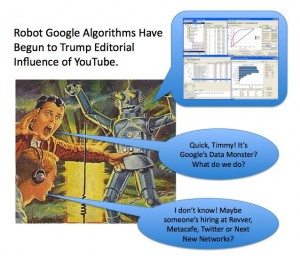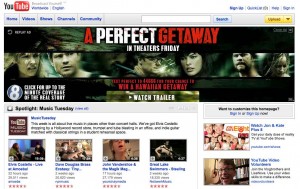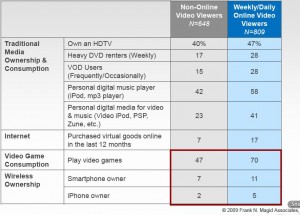Man that headline will sell. Truth is, I am very careful about NOT revealing confidential information on this blog that I learn from Google employees, as a YouTube partner, or through my conversations with industry colleagues or creators.
But most of this is public now, or based on educated assumptions topped with a saucy tabloid-like flare. On a similar note, YouTube’s Business Blog published a refreshingly transparent POV about some YouTube myths recently. Did you know that 70% of Ad Age top 100 marketers ran YouTube campaigns in 2008?
Here are the secrets the YouTube PR folks won’t reveal:

1) YouTube is Monetizing Fewer than 9 Percent of Its Videos. But Who Cares? Kudos to Jason Kincaid for doing fancy math to figure out what percent of videos YouTube is monetizing (meaning the site is making money instead of paying to stream and bleeding money). The answer was 8.5%, which is close to AdAge’s 8.7% estimate (CNN Money claims 13%). Of course, monetizing could mean shitty lil’ penny banner buys, decent InVideo sponsorships, homepage takeovers, or premium rev-share deals. It’s long been rumored to be 3-5 percent monetization, but let’s get real. Google could turn that number to 100% by simply running Adsense indescriminately on each page. So I’d be less concerned about the percent than the profitability.
Thanks to YouTube my videos are seen 200-250,000 times a day (yey, Uncle Google). That wouldn’t happen any other way, and I’m only hoping the biz-dev folks enhance the average profit per-monetized video before it bothers chasing the impossible-to-monetize-well long tail. This is happening as we speak with new revenue boosting options.
If I got a penny per view, I’d earn $730,000.00 this year. I’m not, mkay?
2) Algorithms Squashed the Editors. Almost nothing you see on YouTube is by accident… or an editor anymore. While YouTube editors once possessed more power than most network executives (creating instant celebrities by homepage feature pixie dust), the model is now driven almost exclusively by relevancy and economics. Recently, YouTube announced content creators and small advertisers can get their videos promoted for a fee… and not just against search results. Editors continue to serve some role on the “spotlight” pages and community relations, but are not the Titans they were in 2006 and 2007. That said, we still love them deeply because our love was unrequited. Especially when they put us on Partner showcase pages.

3) YouTube Still Plays Favorite, and especially for “TV Shows.” Lately, YouTube has worked hard to pimp its “shows,” a collection of retro TV that lost its charm faster than Bazooka loses its taste. Ba-boom. There also are some YouTube partners that live on the home-page (CommunityChannel), the recommendation section for new registrants to YouTube, or are “micro-featured” everywhere. We don’t know whether the editors are doing this, or the algorithms are saying: “these guys are good YouTube-addiction starter drugs.” But we do know that if a human does have any input to this “favoritism,” the person is probably really smart, attractive and has good breath. Man I’d like to meet ’em!
4) It’s All About Your Relatives: Not Keywords and Viral. Think viral-views is the engine behind YouTube? Wrong. It’s about having a steady daily audience (like many, but not all, of the top 100 most-subscribed) and having your videos appear as a related video to popular videos… in other words, via ad, editor or algorythm, getting next to watched videos. Just like being next to a pretty girl makes you look cooler.
A visit to YouTube is often a chain reaction. You start to watch one video, and several related videos draw you deeper. Metacafe was once the master of this, and now YouTube is drawing upon its data-oriented parent, Google, to facilitate what I call the “video roach motel” model. This will get better with time, as we move from “title, tag, description” as being the view driver, to that mystical thing called “relevancy.”
What’s relevancy? I’ll give you two examples: if someone searching Google returns instantly after clicking on a result, that page is penalized on the rankings. Presumably it wasn’t what the searcher wanted. On YouTube, if a video is poorly rated and/or is viewed for a percentage that’s far below average for its total duration, it will eventually be penalized. Example two: on Amazon, there’s a high correlation between Wayne Dyer and Dr. Seuss book purchases, then those two books are related. The machine is getting smarter based on universal behaviors and your own preferences. Soon enough, my audience will be a smaller percent of YouTube but hopefully larger and more appropriate. That’s because we’ll see more of “people who like Shaycarl may also like Nalts.” (And although I may not be as funny or cute, I’ll look thinner to those viewers).
Neither of these models requires indexing the content, mind you. So in theory a video could be relevant to you without the algorithm even knowing what’s being spoken (remember years ago we thought all video would be transcribed to facilitate SEO… and that we’d be driving space cars by now?).
5) YouTube May Not be Hurting, But it’s Hungry. Google was the first to abandon banners and move entirely to a bid model. But YouTube, in a Yahoo-like move, has blitzed in past few months with homepage takeovers. Folks, there’s no reason for ads to represent 50% of the site’s homepage (above the fold) unless you’re trying to show fast revenue. It’s not Googlesque (even if CNN Money maintains that Google hearts YouTube). Of course the rice-sized brained media buyers are using this precious space to simply drive awareness instead of engagement: most of the homepage takeovers are for films, and there’s usually nothing more than a trailer to compel interaction.
CNN Money suggests all is zen-like between YouTube and Google. Hey, even if YouTube captured as much as 1 billion in annual revenue, that’s 1/30th of what Google does. Meh. So if YouTube bleeds a few hundred million to run itself ($83-$350 million in infrastructure/hosting alone, and — who knows — $250 million to maybe $500 million in a year), who cares as long as it has strategic long-term value? Online video is white hot, and it’s just a matter of expediting the future and reducing the blood loss. Of course, all of this is speculation, and Google/YouTube aint talking.
6) Why YouTube Can’t Discuss Real Profit/Loss. No, YouTube doesn’t want you knowing about its economics, but I have 3 words for the curious: stop asking, idiot. YouTube can’t over or understate financials, yet journalists whine about the company’s decision to not publish profitability (or even costs or revenue specifics). Imagine the channel conflicts disclosure would create! If it’s horrible, YouTube has dimished street credibility with media outlets, downstream distribution partners, and advertisers… not to mention shareholders. If it’s schweet, then it attracts copyright attorneys like watermelon at a picnic. But should YouTube reveal case study ROIs (with permission of advertisers) to legitimize the medium to marketers? Uh- yeah. Glad you asked. I give YouTube a D minus on this.
7) Steven Chen’s Latest Contribution. YouTube won’t likely be issuing press releases about Steven Chen, who has continued to vanish from the public light. But thankfully, Chen disintermediated his employer and shared his latest project — which includes a golf swing. Hey, he’s got billions in the bank. What would you do? Probably build a coffee bar. Or buy the car you’ve saved up for since 2005. For nostalgia, check out Chen when Google bought in.
Shit. This post took me hours of time I could have otherwise spent trying to, um, make money. At least there will be a few comments from the back row. Right?



